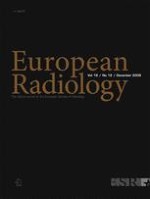Published in:

01-12-2008 | Magnetic Resonance
High-resolution multicontrast-weighted MR imaging from human carotid endarterectomy specimens to assess carotid plaque components
Authors:
Sebastiano Fabiano, Stefano Mancino, Matteo Stefanini, Marcello Chiocchi, Alessandro Mauriello, Luigi Giusto Spagnoli, Giovanni Simonetti
Published in:
European Radiology
|
Issue 12/2008
Login to get access
Abstract
The American Heart Association modified classification for atherosclerotic plaque lesions has defined vulnerable plaques as those prone to rupture. The aim of our study was to assess the sensitivity and specificity of 1.5-T magnetic resonance imaging (MRI) in the evaluation of the characteristics of plaque components. Twelve carotid endarterectomy specimens were imaged by ex-vivo high-resolution 1.5-T MRI. Thirty-four cross-section axial images were selected for pixel-by-pixel basis analysis to demonstrate the most significant tissue features. Data were then submitted for histopathological examination and each specimen analysed in the light of the histological components (lipid core, fibrous tissue, fibrous/loose connective tissue, calcifications). The overall sensitivity and specificity rates for each tissue type were, respectively, 92% and 74% for the lipid core, 82% and 94% for the fibrous tissue, 72% and 87% for the fibrous/loose connective tissue, and 98% and 99% for calcification. The use of 1.5-T MRI appears to be a reliable tool to characterise plaque components and could help in the screening of patients with high risk of plaque rupture. The possibility of applying MRI in clinical daily practice may change the non-invasive approach to carotid artery diagnostic imaging, thus allowing an early identification of patients with vulnerable plaques.